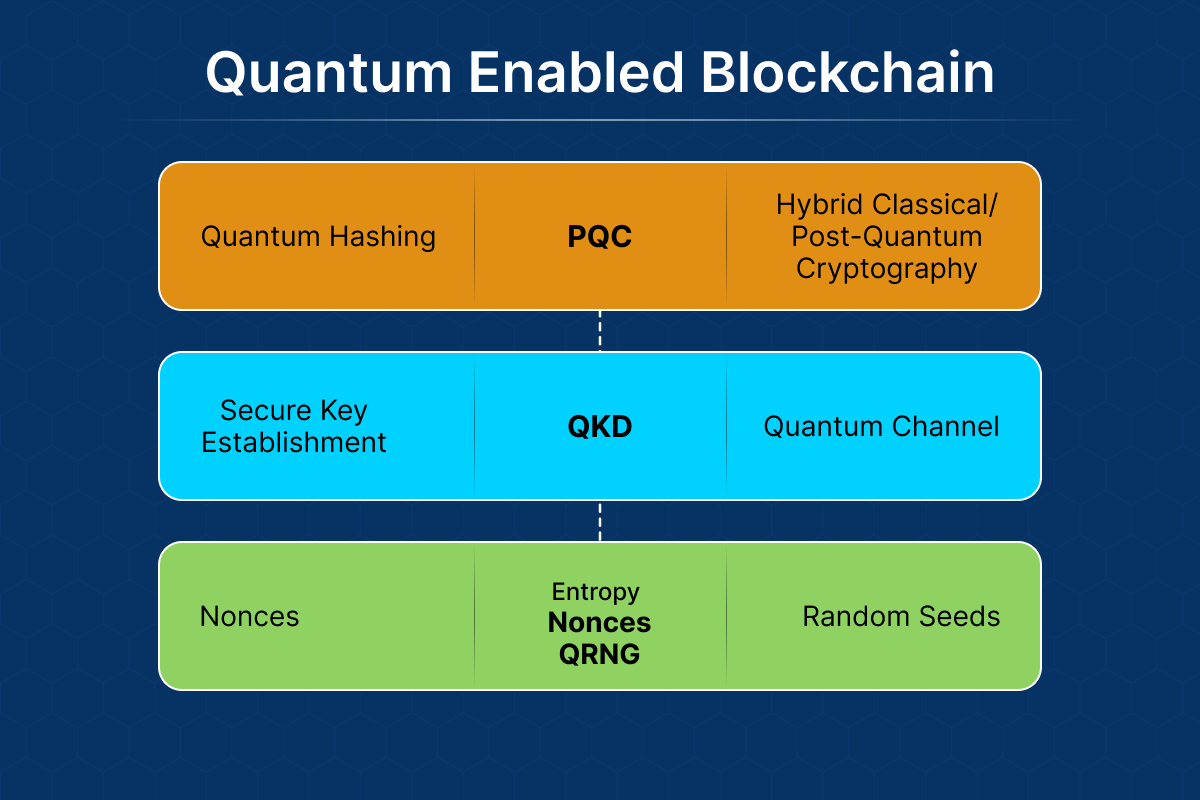SHARE THIS ARTICLE
The Quantum Threat: Can Quantum Computing Crack Blockchain Security?

Blockchain technology has taken the world by storm, offering a secure and transparent way to record transactions without relying on central authorities. From revolutionizing finance to optimizing supply chains, its applications are myriad. However, a new force is emerging on the horizon, one that could potentially shatter the very foundation of Web3 development services and blockchain security: quantum computing.
Quantum computing is developing rapidly; it utilizes quantum mechanics to perform calculations beyond the reach of traditional computers. While still in its early stages, the technology has the potential to disrupt numerous industries and blockchain is no exception. One of the most pressing concerns surrounding this imminent technology is its potential to crack the cryptographic codes that ensure the security of blockchain networks.
Can quantum computers truly threaten blockchain security? In this article, we will explore the complexities of this issue, along with potential threats posed by quantum computing, vulnerabilities of current blockchain cryptography, and the ongoing efforts to develop solutions for a quantum-resistant future.
Understanding the Technology Behind Quantum Computing
Understanding the basic principles of quantum mechanics is crucial to grasp the potential threat it poses to blockchain security. Let’s take the example of a coin to understand how the foundational technology of traditional computing and quantum computing differ. Tradition computer bit, powered by binary language, works more like a coin – which can be heads or tails - existing in one state or the other (either 1 or 0). On the other hand, a qubit – the building block of quantum computers – is like a spinning coin, simultaneously heads and tails (both 1 and 0) until you stop it and observe. This state of “both-at-once” is known as superposition, representing both possibilities simultaneously until measured.
This unique property, along with another phenomenon called entanglement allows quantum to perform calculations in an entirely different way. To understand entanglement, consider two spinning coins, where stopping one instantly determines the state of the other, no matter the distance separating them. As a result, qubits become linked, influencing each other even when physically apart.

Owing to these extraordinary properties of qubits, quantum computers can store and process much more information compared to classical bits. While traditional computers tackle problems one step at a time, quantum computers can explore multiple possibilities simultaneously, making them exponentially faster for specific problems. This is where the concern arises.
Two specific algorithms, Shor’s algorithm and Grover’s algorithm, are particularly worrisome. Shor’s algorithm, for example, can theoretically break the encryption used in many blockchain systems, compromising digital signatures and transaction verification. Similarly, Grover’s algorithm can significantly speed up searches within vast databases, potentially impacting blockchain’s security features. While these algorithms are still under development, their theoretical capabilities highlight the potential vulnerability of current blockchain cryptography to quantum computing.
Vulnerability of Current Blockchain Security
The robust security of blockchain technology hinges on public-key cryptography. This system utilizes two mathematically linked keys – a widely shared public key for receiving data, and a secret private key for signing and decrypting data. Common public-key cryptography algorithms used in blockchain include RSA and ECC. These algorithms are the backbone of secure transactions, ensuring authenticity and preventing unauthorized access.
However, these algorithms, while secure against traditional computers, become vulnerable when up against quantum computing. Shor's algorithm, as mentioned earlier, poses a significant threat. It can theoretically break the encryption used in these algorithms, potentially allowing someone to:
-
Break Digital Signatures and Verification
Utilizing Shor’s algorithm, a malicious actor with access to a powerful quantum computer could forge digital signatures, which would allow them to impersonate legitimate users and tamper with transactions on the blockchain. Additionally, they could decrypt private keys, thereby gaining unauthorized access to cryptocurrency wallets and controlling a user’s funds stored on a blockchain.
-
Impact on Hash Functions
While not directly broken by Shor's algorithm, the hash functions used for data integrity on the blockchain could be rendered vulnerable by other quantum algorithms still under development. These functions ensure that data on the blockchain remains unaltered and reliable. If compromised, attackers could tamper with data records, jeopardizing the entire system's integrity.
-
Wide Blockchain Applications
The potential impact of quantum computing is not limited to digital signatures and hash functions. It could also affect other aspects like mining. Many popular cryptocurrencies, like Bitcoin, utilize proof-of-work (PoW) mining, where miners compete to solve complex puzzles to validate transactions. Quantum computers, if powerful enough, could potentially solve these puzzles significantly faster than current mining hardware. This could disrupt the system, allowing control over rewards and potentially launching 51% attacks. While the timeline for such threats is uncertain, with estimates ranging from 2028 onwards, it's a crucial aspect to consider for the long-term viability of PoW-based blockchains.
Plus, the consensus mechanisms used in certain blockchains to ensure agreement on the state of the network might also be susceptible to disruption by quantum algorithms.

While the theoretical threat posed by quantum computing is significant, it's important to note that we are still in the early stages of this technology's development. Building powerful enough quantum computers to execute these complex attacks on a large scale might still be some time away. Nevertheless, the potential consequences necessitate proactive measures to protect the future of blockchain technology.
The Race for Quantum-Resistant Solutions
The potential vulnerabilities exposed by quantum computing might seem daunting, however, the blockchain community is actively working on plausible quantum-resistant solutions. One of the most prominent of them is Post-Quantum Cryptography (PQC). It is a category of cryptographic algorithms specifically designed to be resistant to attacks from quantum computers. These algorithms leverage different mathematical problems, making them incredibly difficult for even the most powerful quantum computers to crack.
Researchers worldwide are actively engaged in developing and refining PQC algorithms. Some promising candidates include:
Lattice-Based Cryptography
This approach utilizes the complex properties of mathematical lattices, structures resembling grids with specific properties. Breaking the encryption would require solving complex problems within these lattices, proving computationally infeasible for quantum computers.
Hash-based cryptography
This category relies on cryptographic hash functions, one-way functions (the same technology behind blockchain's data integrity checks) that transform data into unique "fingerprints." These algorithms are designed to be resistant to various attacks, including those potentially enabled by quantum computers.
These are just a few examples, and research in the field of PQC is constantly evolving. The National Institute of Standards and Technology (NIST) in the US is leading a global effort to standardize PQC algorithms, ensuring interoperability and widespread adoption across various industries, including blockchain.
The standardization process involves rigorous testing and evaluation to make sure the chosen algorithms are truly quantum-resistant and efficient for real-world applications. While there's no single "silver bullet" solution yet, the ongoing research and standardization efforts provide a hopeful outlook for securing the future of blockchain in a quantum era.
It's important to acknowledge that transitioning to PQC algorithms will require significant effort from the blockchain community. Blockchain consulting companies and developers will need to update protocols and infrastructure to integrate these new algorithms, and users might need to adapt their tools and wallets. However, considering the potential consequences of neglecting this crucial step, proactive measures are essential to ensure the long-term viability and security of blockchain technology.
What Does the Future Hold?
While the possibility of quantum computing cracking current blockchain cryptography raises concerns, it's important to remember that the dawn of this technology might not be just about threats. Quantum computing also presents potential opportunities for blockchain. For instance, quantum key distribution (QKD) offers a highly secure way to exchange encryption keys, potentially bolstering the overall security of blockchain systems in the future.
 Despite all the challenges, the ongoing efforts to develop and implement quantum-resistant solutions paint a forward-looking picture for the future of blockchain. The dedication of the blockchain community, along with continuous advancements in PQC research and standardization, demonstrates a commitment to securing this revolutionary technology in the face of the quantum threat. In any case, the intersection of quantum computing and blockchain promises to be an exciting, albeit challenging, aspect of technological evolution.
Despite all the challenges, the ongoing efforts to develop and implement quantum-resistant solutions paint a forward-looking picture for the future of blockchain. The dedication of the blockchain community, along with continuous advancements in PQC research and standardization, demonstrates a commitment to securing this revolutionary technology in the face of the quantum threat. In any case, the intersection of quantum computing and blockchain promises to be an exciting, albeit challenging, aspect of technological evolution.
Furthermore, staying informed about PQC advancements is crucial, especially considering the $1.15 trillion+ global crypto market. As cryptocurrencies become increasingly integral to investment portfolios, entities like asset managers and public companies may need to consider disclosing the potential impact of quantum computing on their investments. Transparency is key to navigating this evolving landscape and ensuring responsible investment practices.
Post Author

Vivek is a passionate writer and technology enthusiast with expertise in blockchain development. As the lead writer for Codezeros, he aims to educate and inform readers about the potential of blockchain technology and simplify complex concepts to present them in an engaging manner for both technical and non-technical readers.
Want your next dApp project to be future-proof?
At Codezeros, our team of blockchain experts consistently upskills themselves with the evolving trends and industry practices and can help you build secure, scalable, and future-proof dApps.



